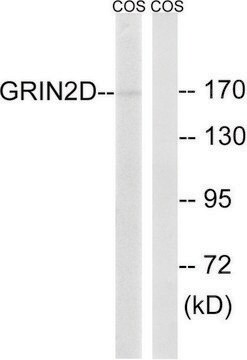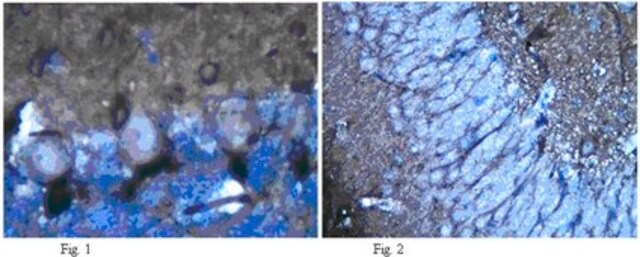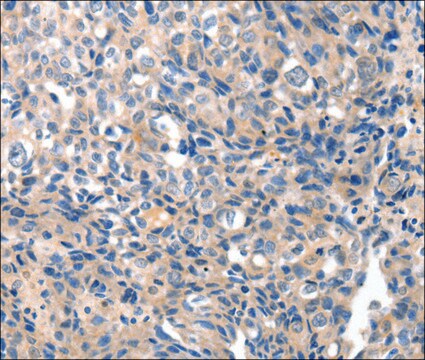MAB5578
Anti-NMDAR2D Antibody
ascites fluid, clone 1G9.39A5, Chemicon®
Iniciar sesiónpara Ver la Fijación de precios por contrato y de la organización
About This Item
Código UNSPSC:
12352203
eCl@ss:
32160702
NACRES:
NA.41
Productos recomendados
origen biológico
mouse
Nivel de calidad
forma del anticuerpo
ascites fluid
clon
1G9.39A5, monoclonal
reactividad de especies
human, mouse, rat, rabbit
fabricante / nombre comercial
Chemicon®
técnicas
western blot: suitable
isotipo
IgG2b
Nº de acceso NCBI
Nº de acceso UniProt
Condiciones de envío
dry ice
modificación del objetivo postraduccional
unmodified
Información sobre el gen
human ... GRIN2D(2906)
Especificidad
NMDAR2D, C-terminal. By Western blot the antibody reacts with a weak band at ~145. An additional band at ~75 kDa may be seen depending on sample and antibody concentration used.
Inmunógeno
Recombinant protein from rat NMDAR2D.
Aplicación
Anti-NMDAR2D Antibody detects level of NMDAR2D & has been published & validated for use in WB.
Research Category
Neuroscience
Neuroscience
Research Sub Category
Neurotransmitters & Receptors
Neurotransmitters & Receptors
Western blot: 1:500-1:1,000 on rat brain lysate.
Optimal working dilutions must be determined by end user.
Optimal working dilutions must be determined by end user.
Forma física
Liquid.
Almacenamiento y estabilidad
Maintain at -20°C in undiluted aliquots for up to 6 months after date of receipt. Avoid repeated freeze/thaw cycles.
Nota de análisis
Control
Rat forebrain or cerebellum.
Rat forebrain or cerebellum.
Información legal
CHEMICON is a registered trademark of Merck KGaA, Darmstadt, Germany
Cláusula de descargo de responsabilidad
Unless otherwise stated in our catalog or other company documentation accompanying the product(s), our products are intended for research use only and are not to be used for any other purpose, which includes but is not limited to, unauthorized commercial uses, in vitro diagnostic uses, ex vivo or in vivo therapeutic uses or any type of consumption or application to humans or animals.
Código de clase de almacenamiento
10 - Combustible liquids
Clase de riesgo para el agua (WGK)
WGK 1
Punto de inflamabilidad (°F)
Not applicable
Punto de inflamabilidad (°C)
Not applicable
Certificados de análisis (COA)
Busque Certificados de análisis (COA) introduciendo el número de lote del producto. Los números de lote se encuentran en la etiqueta del producto después de las palabras «Lot» o «Batch»
¿Ya tiene este producto?
Encuentre la documentación para los productos que ha comprado recientemente en la Biblioteca de documentos.
Sharon A Swanger et al.
The Journal of neuroscience : the official journal of the Society for Neuroscience, 35(48), 15971-15983 (2015-12-04)
The GluN2D subunit of the NMDA receptor is prominently expressed in the basal ganglia and associated brainstem nuclei, including the subthalamic nucleus (STN), globus pallidus, striatum, and substantia nigra. However, little is known about how GluN2D-containing NMDA receptors contribute to
Gajanan P Shelkar et al.
Scientific reports, 9(1), 7572-7572 (2019-05-22)
The GluN2C- and GluN2D-containing NMDA receptors are distinct from GluN2A- and GluN2B-containing receptors in many aspects including lower sensitivity to Mg2+ block and lack of desensitization. Recent studies have highlighted the unique contribution of GluN2C and GluN2D subunits in various
D J Laurie et al.
Brain research. Molecular brain research, 51(1-2), 23-32 (1998-01-14)
Mouse monoclonal antibodies were raised against bacterially expressed protein sequences of the NR2A, NR2B, NR2C and NR2D subunits of the rat NMDA receptor. From immunoblots of rat brain proteins, the apparent molecular weights of these subunits were 165, 170, 135
Jinxu Liu et al.
Neurobiology of disease, 150, 105254-105254 (2021-01-10)
Globus pallidus externa (GPe) is a nucleus in the basal ganglia circuitry involved in the control of movement. Recent studies have demonstrated a critical role of GPe cell types in Parkinsonism. Specifically increasing the function of parvalbumin (PV) neurons in
Jeremy S Lum et al.
Neurochemical research, 43(8), 1683-1691 (2018-06-25)
Dysfunction of the glutamatergic system is believed to underlie many neurodevelopmental disorders including autism, Rett syndrome and schizophrenia. Metabotropic glutamate receptor (mGluR5) positive allosteric modulators (PAM) potentiate glutamatergic signaling, particularly indirectly via the NMDA receptor. Preclinical studies report mGluR5 PAMs
Nuestro equipo de científicos tiene experiencia en todas las áreas de investigación: Ciencias de la vida, Ciencia de los materiales, Síntesis química, Cromatografía, Analítica y muchas otras.
Póngase en contacto con el Servicio técnico







